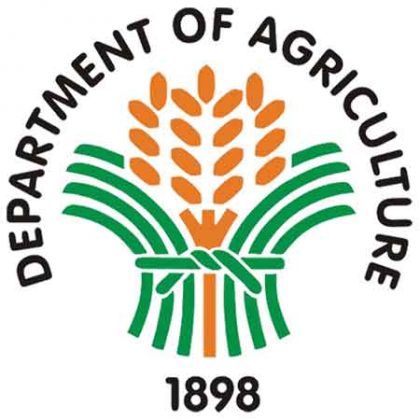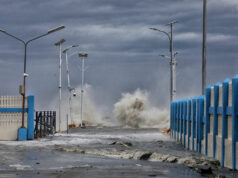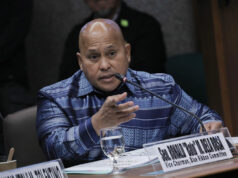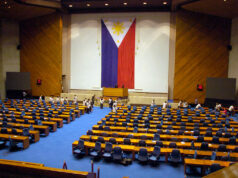Seafarers face job uncertainty due to PHL travel restrictions
UP TO 40,000 Filipino seafarers, including those who work on cruise ships, may not get rehired by their companies due to travel restrictions being imposed by the Philippine government in a bid to contain the spread of the coronavirus disease 2019 (COVID-19).
“Many of them have no assurance of getting hired back. And… we make the lives of our seafarers more miserable with a lot of other restrictions, which we understand also for us to be able to contain the spread of the virus, but we should consider that we need to protect even our own jobs,” Eduardo Ma. R. Santos, executive vice-president of the Associated Marine Officers’ and Seamen’s Union of the Philippines (AMOSUP), said in a phone interview.
Mr. Santos, also president of the Maritime Academy of Asia and the Pacific, said about 20,000 seafarers, mostly from cruise lines, have already returned to the country.
A batch of 4,559 workers in cruise ships from Australia, Indonesia, Singapore, and Japan are expected to disembark at the country’s ports on May 17, after completing their 14-day quarantine at anchorage, the Bureau of Immigration reported on Tuesday.
Eight other cruise ships and three maritime vessels are expected to arrive next week, the bureau said.
Seafarers from all types of vessels, like all other returning overseas Filipino workers (OFWs), are quarantined for 14 days before being allowed on shore.
Mr. Santos said the Philippines has more than 300,000 seafarers, and he expects the number “to be deeply reduced if they don’t get any renewal of contracts and replacements.”
Others still on board have been forced to extend their contracts, which Mr. Santos said could be a drawback in terms of efficiency.
“If you let them stay longer on board, that will affect their efficiency kasi nga banas na banas na sila, nasa barko na isang taon eh (because they will become irritated, being in a ship for a year),” he said.
Industry groups have been lobbying to ease travel restrictions on seafarers, who sent $6.5 billion in remittances last year, accounting for 22% of the total $30.1 billion sent home by Filipino workers overseas, according to data from the central bank.
Mr. Santos noted that other labor supply countries such as India and those in Eastern Europe give their seafarers considerable leeway to move in and out of their respective countries although they have more COVID-19 infections than the Philippines.
Further, he said, seafarers struggle to get employment contracts which are processed by the Philippine Overseas Employment Administration that currently operates under a skeleton workforce because of the quarantine rules.
The International Air Transport Association (IATA) and the International Chamber of Shipping (ICS) have said the government should identify airports that international transport personnel, who have been affected by travel restrictions, can use for crew changes and make appropriate adjustments to the current health and immigration protocols.
IATA and ICS said that regulations intended for passengers and non-essential personnel unnecessarily jeopardize the ability of airlines and shipping companies to keep global supply chains operating when such restrictions are applied to transport personnel who do not engage with local communities.
President Rodrigo R. Duterte, meanwhile, warned local government units of sanctions if they refuse to allow repatriated OFWs to return to their hometowns over health safety fears.
In an evening briefing on Monday, Mr. Duterte said, “Magkakaroon tayo ng problema (There will be a problem) if you resist because then as a worker of government, it falls upon my shoulders to see to it that everything is done fair.” — Arjay L. Balinbin with Vann Marlo M. Villegas and Gillian M. Cortez
Gov’t targets 78 COVID-19 test centers by end-May
THE government is aiming to have 78 testing centers for the coronavirus disease 2019 (COVID-19) operational by end-May, with a combined 30,000 daily testing capacity.
Vivencio “Vince” B. Dizon, deputy chief implementer of the national policy against COVID-19, said during a Monday evening briefing that the goal is to “ramp up testing,” especially while there is no approved vaccine yet to defeat the virus.
In a separate briefing on Tuesday, the government launched its T3 or the Test, Trace, and Treat Program.
“Kapag tayo po ay umabot ng 30,000 per day, nandoon na po tayo sa level ng testing katulad ng mga bansang talagang nag-invest sa testing tulad ng South Korea at ng mga iba pang bansa; at mas mataas pa tayo sa level ng Singapore at ng Israel (If we reach up to 30,000 per day, we are at the level of countries that really invested such as South Korea and other countries, and we will be at a higher level than Singapore and Israel),” he said.
The government will also open four “mega” swabbing centers in Metro Manila this week, which can cover 5,000 samples a day.
Meanwhile, the Inter-Agency Task Force for the Management of Emerging Infectious Diseases (IATF-EID) will form a committee that will focus on screening areas that will undergo an enhanced community quarantine (ECQ), wherein stringent rules are implemented.
On Tuesday, Palace Spokesperson Harry L. Roque said the IATF-EID has approved the document containing guidelines for imposing ECQ at different local government levels.
The new parameters will be used to determine areas that will need to continue or can forego restrictions in the face of the COVID-19 threat.
Mr. Roque also said the task force has also formed the IATF Screening and Validation Committee, which is composed of different government agencies.
Starting May 1, areas considered as under low to moderate risk of the COVID-19 spread have been directed to ease restrictions, including resumption of public transport and reopening of more businesses.
A number of local governments, however, appealed to maintain the ECQ policy.
Mr. Roque said there are currently seven areas that have a pending appeal. — Gillian M. Cortez
Agri dep’t resumes full operations in all offices

THE Department of Agriculture (DA), including its attached bureaus and agencies, has resumed full operations in its offices nationwide following Secretary William D. Dar’s order on Monday to deliver services to the sector.
Mr. Dar said among the crucial services needed relate to production, marketing, and financial assistance.
The directive is in compliance with the “Omnibus guidelines on the implementation of community quarantine in the Philippines,” a part of President Rodrigo R. Duterte’s Executive Order No. 112.
Mr. Dar also instructed all DA offices to ensure the unhampered movement of agricultural frontliners such as farmers, fisherfolk, agri-fishery processing and manufacturing personnel, and employees at central and regional field offices.
He added that all farm and fishery workers and employees must follow health and safety measures set by the Inter-Agency Task Force for the Management on Emerging Infectious Diseases.
“Those with health issues, regardless of age, will not be allowed to go back to work. We need to minimize the risk among farmers and fisherfolk, as well as our employees, and avoid becoming part of the coronavirus disease 2019 (COVID-19) statistics,” Mr. Dar said.
Under the revised guidelines of Executive Order 112, several areas have been classified as high-risk areas and still placed under enhanced community quarantine (ECQ) until May 15.
These areas include the National Capital Region, Central Luzon except Aurora, CALABARZON Region, Pangasinan, Benguet including Baguio City, Iloilo, Iloilo City, Cebu, Cebu City, Bacolod City, and Davao City.
All other localities areas must transition to the less stringent general community quarantine rules starting May 1, although some local government units (LGUs) continue to implement tight restrictions.
“We have no problem with LGUs that wish to pursue ECQ, as long as all activities related to agriculture and food production remain unimpeded,” Mr. Dar said.
The DA recently called for the establishment of “mobility corridors” for food supply chain players to have uninterrupted movement and delivery of commodities.
“As we have stated time and again, the threat of hunger is as real as the threat of COVID-19. We must look beyond the crisis and prepare for the aftermath, and more importantly how to adequately feed 110 million Filipinos,” Mr. Dar said. — Revin Mikhael D. Ochave
DoTr to help stranded students; PayMaya distributes gov’t financial aid
THE Department of Transportation (DoTr) is planning to propose a program that would help stranded students go back to their hometowns.
DoTr, in a statement, said it has started gathering data for the feasibility of its program, which will be called “Hatid-Estudyante Program.” The plan will be presented for approval by the national task force handling the coronavirus disease 2019 (COVID-19) response.
The department noted that there are students in Metro Manila who have been stranded in their dormitories, apartment, and even campuses due to the government-imposed lockdown.
“To initiate the process, the Department of Transportation has set up an online enrollment platform where the stranded students may send the needed information (to include their personal details, current location, destination, health declaration), school ID (or proof of enrollment) and parental consent [if minor] to be tested for COVID-19,” DoTr said.
Meanwhile, Digital Payments firm PayMaya Philippines, Inc. and its remittance brand Smart Padala said they have been tapped by the Caloocan City government to distribute its financial aid to about 13,000 students of the University of Caloocan.
“Once received, the funds can be encashed through more than 800 Smart Padala centers in Caloocan alone and several hundreds more in adjacent cities, many of which are available even in small neighborhoods. Students may also choose to use the cash aid to pay their bills, buy airtime load, send money to family, or do online groceries using the PayMaya app,” it said.
PayMaya said the amount being disbursed is more than P14 million. — Arjay L. Balinbin
P30K reward awaits informants on cash aid corruption
PRESIDENT Rodrigo R. Duterte has promised a P30,000 bounty each for informants whose reports are proven true on anomalous activities by local officials relating to the distribution of the coronavirus diseases 2019 (COVID-19) cash aid program.
Palace Spokesperson Harry L. Roque said in a briefing Monday evening, “Kapag napatunayan yung inyong reklamo sa korapsyon laban sa mga lokal na opisyales na kinukurakot iyong mga ayuda na ipinamimigay ng gobyerno, P30,000 na pabuya na ibibigay ng ating Presidente sa inyo (If the corruption complaint is confirmed, the President will give you a P30,000 reward).”
Mr. Duterte, in his Monday address, cited the case of Bulacan Councilor Danilo Flores who was charged with graft after he was found collecting cash intended as subsidies to beneficiaries.
Interior and Local Government Secretary Eduardo M. Año has also issued a memorandum directing the police to investigate and arrest erring local officials.
“Kung may basehan (If there is basis), they can investigate and make arrest,” Undersecretary Jonathan E. Malaya, the department spokesperson, said in an interview over dzMM on Tuesday. — Gillian M. Cortez and Emmanuel Tupas, PHILSTAR



